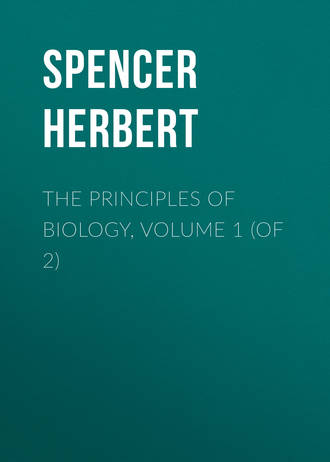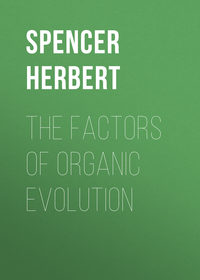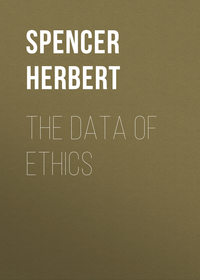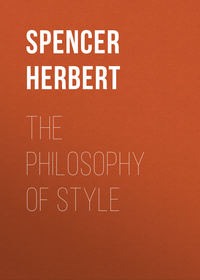 полная версия
полная версияThe Principles of Biology, Volume 1 (of 2)
CHAPTER VI.
INDIVIDUALITY
§ 72. What is an individual? is a question which many readers will think it easy to answer. Yet it is a question that has led to much controversy among Zoologists and Botanists, and no quite satisfactory reply to it seems possible. As applied to a man, or to any one of the higher animals, which are all sharply-defined and independent, the word individual has a clear meaning: though even here, when we turn from average cases to exceptional cases – as a calf with two heads and two pairs of fore-limbs – we find ourselves in doubt whether to predicate one individuality or two. But when we extend our range of observation to the organic world at large, we find that difficulties allied to this exceptional one meets us everywhere under every variety of form.
Each uniaxial plant may perhaps fairly be regarded as a distinct individual; though there are botanists who do not make even this admission. What, however, are we to say of a multiaxial plant? It is, indeed, usual to speak of a tree with its many branches and shoots as singular; but strong reasons may be urged for considering it as plural. Every one of its axes has a more or less independent life, and when cut off and planted may grow into the likeness of its parent; or, by grafting and budding, parts of this tree may be developed upon another tree, and there manifest their specific peculiarities. Shall we regard all the growing axes thus resulting from slips and grafts and buds, as parts of one individual or as distinct individuals? If a strawberry-plant sends out runners carrying buds at their ends, which strike root and grow into independent plants that separate from the original one by decay of the runners, must we not say that they possess separate individualities; and yet if we do this, are we not at a loss to say when their separate individualities were established, unless we admit that each bud was from the beginning an individual? Commenting on such perplexities Schleiden says – "Much has been written and disputed concerning the conception of the individual, without, however, elucidating the subject, principally owing to the misconception that still exists as to the origin of the conception. Now the individual is no conception, but the mere subjective comprehension of an actual object, presented to us under some given specific conception, and on this latter it alone depends whether the object is or is not an individual. Under the specific conception of the solar system, ours is an individual: in relation to the specific conception of a planetary body, it is an aggregate of many individuals." … "I think, however, that looking at the indubitable facts already mentioned, and the relations treated of in the course of these considerations, it will appear most advantageous and most useful, in a scientific point of view, to consider the vegetable cell as the general type of the plant (simple plant of the first order). Under this conception, Protococcus and other plants consisting of only one cell, and the spore and pollen-granule, will appear as individuals. Such individuals may, however, again, with a partial renunciation of their individual independence, combine under definite laws into definite forms (somewhat as the individual animals do in the globe of the Volvox globator25). These again appear empirically as individual beings, under a conception of a species (simple plants of the second order) derived from the form of the normal connexion of the elementary individuals. But we cannot stop here, since Nature herself combines these individuals, under a definite form, into larger associations, whence we draw the third conception of the plant, from a connexion, as it were, of the second power (compound plants – plants of the third order). The simple plant proceeding from the combination of the elementary individuals is then termed a bud (gemma), in the composition of plants of the third order."
The animal kingdom presents still greater difficulties. When, from sundry points on the body of a common polype, there bud out young polypes which, after acquiring mouths and tentacles and closing up the communications between their stomachs and the stomach of the parent, finally separate from the parent; we may with propriety regard them as distinct individuals. But when in the allied compound Hydrozoa, we find that these young polypes continue permanently connected with the parent; and when by this continuous budding-out there is presently produced a tree-like aggregation, having a common alimentary canal into which the digestive cavity of each polype opens; it is no longer so clear that these little sacs, furnished with mouths and tentacles, are severally to be regarded as distinct individuals. We cannot deny a certain individuality to the polypedom. And on discovering that some of the buds, instead of unfolding in the same manner as the rest, are transformed into capsules in which eggs are developed – on discovering that certain of the incipient polypes thus become wholly dependent on the aggregate for their nutrition, and discharge functions which have nothing to do with their own maintenance, we have still clearer proof that the individualities of the members are partially merged in the individuality of the group. Other organisms belonging to the same order, display still more decidedly this transition from simple individualities to a complex individuality. In the Diphyes there is a special modification of one or more members of the polypedom into a swimming apparatus which, by its rhythmical contractions, propels itself through the water, drawing the polypedom after it. And in the more differentiated Physalia various organs result from the metamorphosis of parts which are the homologues of individual polypes. In this last instance, the individuality of the aggregate is so predominant that the individualities of its members are practically lost. This combination of individualities in such way as to produce a composite individual, meets us in other forms among the ascidians. While in some of these, as in the Clavelina and in the Botryllidæ, the animals associated are but little subordinated to the community they form, in others they are so combined as to form a compound individual. The pelagic ascidian Doliolum is an example. "Here we find a large individual which swims by contractions of circular muscular bands, carries a train of smaller individuals attached to a long dorsal process of the test. These are arranged in three rows: those constituting the lateral row have wide mouths and no sexual organs or organs of locomotion – they subserve the nutrition of the colony, a truth which is illustrated by the fact that as soon as they are properly developed the large individual (the mother) loses her alimentary canal;" while from the median row are eventually derived the sexual zoids.
On the hypothesis of Evolution, perplexities of this nature are just such as we might anticipate. If Life in general commenced with minute and simple forms, like those out of which all organisms, however complex, now originate; and if the transitions from these primordial units to organisms made up of groups of such units, and to higher organisms made up of groups of such groups took place by degrees; it is clear that individualities of the first and simplest order would merge gradually in those of a larger and more complex order, and these again in others of an order having still greater bulk and organization. Hence it would be impossible to say where the lower individualities ceased and the higher individualities commenced.
§ 73. To meet these difficulties, it has been proposed that the whole product of a single fertilized germ shall be regarded as a single individual; whether such whole product be organized into one mass, or whether it be organized into many masses that are partially or completely separate. It is urged that whether the development of the fertilized germ be continuous or discontinuous (§ 50) is a matter of secondary importance; that the totality of living tissue to which the fertilized germ gives rise in any one case, is the equivalent of the totality to which it gives rise in any other case; and that we must recognize this equivalence, whether such totality of living tissue takes a concrete or a discrete arrangement. In pursuance of this view, a zoological individual is constituted either by any such single animal as a mammal or bird, which may properly claim the title of a zoon, or by any such group of animals as the numerous Medusæ that have been developed from the same egg, which are to be severally distinguished as zooids.
Admitting it to be very desirable that there should be words for expressing these relations and this equivalence, it may be objected that to apply the word individual to a number of separate living bodies, is inconvenient: conflicting so much, as it does, with the ordinary conception which this word suggests. It seems a questionable use of language to say that the countless masses of Anacharis Alsinastrum (now Eloidea canadensis) which, within these few years, have grown up in our rivers, canals, and ponds, are all parts of one individual: and yet as this plant does not seed in England, these countless masses, having arisen by discontinuous development, must be so regarded if we accept the above definition.
It may be contended, too, that while it does violence to our established way of thinking, this mode of interpreting the facts is not without its difficulties. Something seems to be gained by restricting the application of the title individual, to organisms which, being in all respects fully developed, possess the power of producing their kind after the ordinary sexual method, and denying this title to those incomplete organisms which have not this power. But the definition does not really establish this distinction for us. On the one hand, we have cases in which, as in the working bee, the whole of the germ-product is aggregated into a single organism; and yet, though an individual according to the definition, this organism has no power of reproducing its kind. On the other hand, we have cases like that of the perfect Aphis, where the organism is but an infinitesimal part of the germ product, and yet has that completeness required for sexual reproduction. Further, it might be urged with some show of reason, that if the conception of individuality involves the conception of completeness, then, an organism which possesses an independent power of reproducing itself, being more complete than an organism in which this power is dependent on the aid of another organism, is more individual.
§ 74. There is, indeed, as already implied, no definition of individuality that is unobjectionable. All we can do is to make the best practicable compromise.
As applied either to an animate or an inanimate object, the word individual ordinarily connotes union among the parts of the object and separateness from other objects. This fundamental element in the conception of individuality, we cannot with propriety ignore in the biological application of the word. That which we call an individual plant or animal must, therefore, be some concrete whole and not a discrete whole. If, however, we say that each concrete living whole is to be regarded as an individual, we are still met by the question – What constitutes a concrete living whole? A young organism arising by internal or external gemmation from a parent organism, passes gradually from a state in which it is an indistinguishable part of the parent organism to a state in which it is a separate organism of like structure with the parent. At what stage does it become an individual? And if its individuality be conceded only when it completely separates from the parent, must we deny individuality to all organisms thus produced which permanently retain their connexions with their parents? Or again, what must we say of the Hectocotylus, which is an arm of the Cuttle-fish that undergoes a special development and then, detaching itself, lives independently for a considerable period? And what must we say of the larval nemertine worm the pilidium of which with its nervous system is left to move about awhile after the developing worm has dropped out of it?
To answer such questions we must revert to the definition of life. The distinction between individual in its biological sense, and individual in its more general sense, must consist in the manifestation of Life, properly so called. Life we have seen to be, "the definite combination of heterogeneous change, both simultaneous and successive, in correspondence with external co-existences and sequences." Hence, a biological individual is any concrete whole having a structure which enables it, when placed in appropriate conditions, to continuously adjust its internal relations to external relations, so as to maintain the equilibrium of its functions. In pursuance of this conception, we must consider as individuals all those wholly or partially independent organized masses which arise by multicentral and multiaxial development that is either continuous or discontinuous (§ 50). We must accord the title to each separate aphis, each polype of a polypedom, each bud or shoot of a lowering plant, whether it detaches itself as a bulbil or remains attached as a branch.
By thus interpreting the facts we do not, indeed, avoid all anomalies. While, among flowering plants, the power of independent growth and development is usually possessed only by shoots or axes; yet, in some cases, as in that of the Begonia-leaf awhile since mentioned, the appendage of an axis, or even a small fragment of such appendage, is capable of initiating and carrying on the functions of life; and in other cases, as shown by M. Naudin in the Drosera intermedia, young plants are occasionally developed from the surfaces of leaves. Nor among forms like the compound Hydrozoa, does the definition enable us to decide where the line is to be drawn between the individuality of the group and the individualities of the members: merging into each other, as these do, in different degrees. But, as before said, such difficulties must necessarily present themselves if organic forms have arisen by insensible gradations. We must be content with a course which commits us to the smallest number of incongruities; and this course is, to consider as an individual any organized mass which is capable of independently carrying on that continuous adjustment of inner to outer relations which constitutes Life.
CHAPTER VIA.
CELL-LIFE AND CELL-MULTIPLICATION
§ 74a. The progress of science is simultaneously towards simplification and towards complication. Analysis simplifies its conceptions by resolving phenomena into their factors, and by then showing how each simple mode of action may be traced under multitudinous forms; while, at the same time, synthesis shows how each factor, by cooperation with various other factors in countless modes and degrees, produces different results innumerable in their amounts and varieties. Of course this truth holds alike of processes and of products. Observation and the grouping into classes make it clear that through multitudinous things superficially unlike there run the same cardinal traits of structure; while, along with these major unities, examination discloses innumerable minor diversities.
A concomitant truth, or the same truth under another aspect, is that Nature everywhere presents us with complexities within complexities, which go on revealing themselves as we investigate smaller and smaller objects. In a preceding chapter (§§ 54a, 54b) it was pointed out that each primitive organism, in common with each of the units out of which the higher and larger organisms are built, was found a generation ago to consist of nucleus, protoplasm, and cell-wall. This general conception of a cell remained for a time the outcome of inquiry; but with the advance of microscopy it became manifest that within these minute structures processes and products of an astonishing nature are to be seen. These we have now to contemplate.
In the passages just referred to it was said that the external layer or cell-wall is a non-essential, inanimate part produced by the animate contents. Itself a product of protoplasmic action, it takes no part in protoplasmic changes, and may therefore here be ignored.
§ 74b. One of the complexities within complexities was disclosed when it was found that the protoplasm itself has a complicated structure. Different observers have described it as constituted by a network or reticulum, a sponge-work, a foam-work. Of these the first may be rejected; since it implies a structure lying in one plane. If we accept the second we have to conceive the threads of protoplasm, corresponding to the fibres of the sponge, as leaving interstices filled either with liquid or solid. They cannot be filled with a continuous solid, since all motion of the protoplasm would be negatived; and that their content is not liquid seems shown by the fact that its parts move about under the form of granules or microsomes. But the conception of moving granules implies the conception of immersion in a liquid or semi-liquid substance in which they move – not a sponge-work of threads but a foam-work, consisting everywhere of septa interposed among the granules. This is the hypothesis which sundry microscopists espouse, and which seems mechanically the most feasible: the only one which consists with the "streaming" of protoplasm. Ordinarily the name protoplasm is applied to the aggregate mass – the semi-liquid, hyaline substance and the granules or microsomes it contains.
What these granules or microsomes are – whether, as some have contended, they are the essential living elements of the protoplasm, or whether, as is otherwise held, they are nutritive particles, is at present undecided. But the fact, alleged by sundry observers, that the microsomes often form rows, held together by intervening substance, seems to imply that these minute bodies are not inert. Leaving aside unsettled questions, however, one fact of significance is manifest – an immense multiplication of surfaces over which inter-action may take place. Anyone who drops into dilute sulphuric acid a small nail and then drops a pinch of iron filings, will be shown, by the rapid disappearance of the last and the long continuance of the first, how greatly the increasing of surfaces by multiplication of fragments facilitates change. The effect of subdivision in producing a large area in a small space, is shown in the lungs, where the air-cells on the sides of which the blood-vessels ramify, are less than 1⁄100th of an inch in diameter, while they number 700,000,000. In the composition of every tissue we see the same principle. The living part, or protoplasm, is divided into innumerable protoplasts, among which are distributed the materials and agencies producing changes. And now we find this principle carried still deeper in the structure of the protoplasm itself. Each microscopic portion of it is minutely divided in such ways that its threads or septa have multitudinous contacts with those included portions of matter which take part in its activities.
Concerning the protoplasm contained in each cell, named by some cytoplasm, it remains to say that it always includes a small body called the centrosome, which appears to have a directive function. Usually the centrosome lies outside the nucleus, but is alleged to be sometimes within it. During what is called the "resting stage," or what might more properly be called the growing stage (for clearly the occasional divisions imply that in the intervals between them there has been increase) the centrosome remains quiescent, save in the respect that it exercises some coercive influence on the protoplasm around. This results in the radially-arranged lines constituting an "aster." What is the nature of the coercion exercised by the centrosome – a body hardly distinguishable in size from the microsomes or granules of protoplasm around – is not known. It can scarcely be a repelling force; since, in a substance of liquid or semi-liquid kind, this could not produce approximately straight lines. That it is an attractive force seems more probable; and the nature of the attraction would be comprehensible did the centrosome augment in bulk with rapidity. For if integration were in progress, the drawing in of materials might well produce converging lines. But this seems scarcely a tenable interpretation; since, during the so-called "resting stage," this star-like structure exists – exists, that is, while no active growth of the centrosome is going on.
Respecting this small body we have further to note that, like the cell as a whole, it multiplies by fission, and that the bisection of it terminates the resting or growing stage and initiates those complicated processes by which two cells are produced out of one: the first step following the fission being the movement of the halves, with their respective completed asters, to the opposite sides of the nucleus.
§ 74c. With the hypothesis, now general, that the nucleus or kernel of a cell is its essential part, there has not unnaturally grown up the dogma that it is always present; but there is reason to think that the evidence is somewhat strained to justify this dogma.
In the first place, beyond the cases in which the nucleus, though ordinarily invisible, is said to have been rendered visible by a re-agent, there are cases, as in the already-named Archerina, where no re-agent makes one visible. In the second place, there is the admitted fact that some nuclei are diffused; as in Trachelocerca and some other Infusoria. In them the numerous scattered granules are supposed to constitute a nucleus: an interpretation obviously biassed by the desire to save the generalization. In the third place, the nucleus is frequently multiple in cells of low types; as in some families of Algæ and predominantly among Fungi. Once more, the so-called nucleus is occasionally a branching structure scarcely to be called a "kernel."
The facts as thus grouped suggest that the nucleus has arisen in conformity with the law of evolution – that the primitive protoplast, though not homogeneous in the full sense, was homogeneous in the sense of being a uniformly granular protoplasm; and that the protoplasts with diffused nuclei, together with those which are multi-nucleate, and those which have nuclei of a branching form, represent stages in that process by which the relatively homogeneous protoplast passed into the relatively heterogeneous one now almost universal.
Concerning the structure and composition of the developed nucleus, the primary fact to be named is that, like the surrounding granular cytoplasm, it is formed of two distinct elements. It has a groundwork or matrix not differing much from that of the cytoplasm, and at some periods continuous with it; and immersed in this it has a special matter named chromatin, distinguished from its matrix by becoming dyed more or less deeply when exposed to fit re-agents. During the "resting stage," or period of growth and activity which comes between periods of division, the chromatin is dispersed throughout the ground-substance, either in discrete portions or in such way as to form an irregular network or sponge-work, various in appearance. When the time for fission is approaching this dispersed chromatin begins to gather itself together: reaching its eventual concentration through several stages. By its concentration are produced the chromosomes, constant in number in each species of plant or animal. It is alleged that the substance of the chromosomes is not continuous, but consists of separate elements or granules, which have been named chromomeres; and it is also alleged that, whether in the dispersed or integrated form, each chromosome retains its individuality – that the chromomeres composing it, now spreading out into a network and now uniting into a worm-like body, form a group which never loses its identity. Be this as it may, however, the essential fact is that during the growth-period the chromatin substance is widely distributed, and concentration of it is one of the chief steps towards a division of the nucleus and presently of the cell.
During this process of mitosis or karyokinesis, the dispersed chromatin having passed through the coil-stage, reaches presently the star-stage, in which the chromosomes are arranged symmetrically about the equatorial plane of the nucleus. Meanwhile in each of them there has been a preparation for splitting longitudinally in such way that the halves when separated contain (or are assumed to contain) equal numbers of the granules or chromomeres, which some think are the ultimate morphological units of the chromosomes. A simultaneous change has occurred: there has been in course of formation a structure known as the amphiaster. The two centrosomes which, as before said, place themselves on opposite sides of the nucleus, become the terminal poles of a spindle-shaped arrangement of fibres, arising mainly from the groundwork of the nucleus, now continuous with the groundwork of the cytoplasm. A conception of this structure may be formed by supposing that the radiating fibres of the respective asters, meeting one another and uniting in the intermediate space, thereafter exercise a tractive force; since it is clear that, while the central fibres of the bundle will form straight lines, the outer ones, pulling against one another not in straight lines, will form curved lines, becoming more pronounced in their curvatures as the distance from the axis increases. That a tractive force is at work seems inferable from the results. For the separated halves of the split chromosomes, which now form clusters on the two sides of the equatorial plane, gradually part company, and are apparently drawn as clusters towards the opposing centrosomes. As this change progresses the original nucleus loses its individuality. The new chromosomes, halves of the previous chromosomes, concentrate to found two new nuclei; and, by something like a reversal of the stages above described, the chromatin becomes dispersed throughout the substance of each new nucleus. While this is going on the cell itself, undergoing constriction round its equator, divides into two.









